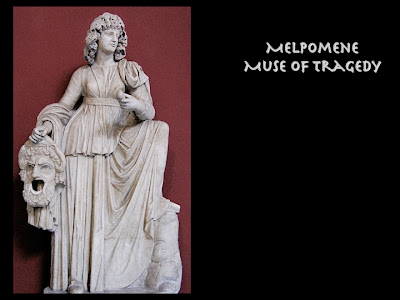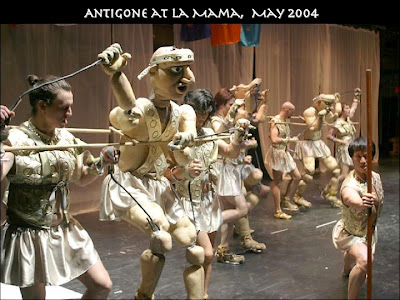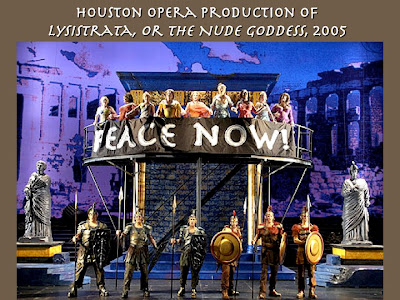So much for the Greek dramatists. THEATRE history, however, includes many other matters, as I noted above. The practical side is as important as the literary – how and where the plays were presented, who played the roles, what kinds of costumes they wore, and of course much more.
We have already been
introduced to the City Dionysia, the
festival held in the city of Athens in early spring that celebrated/appeased
Dionysos. This was not the only festival to Dionysos, and not the only
festival to feature drama, but it’s by far the most important, so we’ll focus
on it in our survey. Each spring Athens opened its doors to the whole
Greek world in this civic and religious week-long festival. While
different scholars offer various theories on the order, here’s how it might
have gone:
1. proagon: before the festival the writers announced the subjects of their plays
2. parade: on the first day, Dionysos's entry into Athens was celebrated with a procession of public officials, producers, actors, featuring gifts and sacrifices to the god
2. parade: on the first day, Dionysos's entry into Athens was celebrated with a procession of public officials, producers, actors, featuring gifts and sacrifices to the god
3. on the second day, ten choruses (one for each tribe of Attica) competed in a dithyramb contest
4. days three to five were devoted to tragedy -- each day one poet presented three tragedies and one satyr play.
5. after 487 BC a comedy contest was added -- five different playwrights presented one play each.
6. on the final day prizes and punishments were given out, and there was a celebration to close the festival.
That’s a
conjectural look at the City Dionysia, approximately one week in early spring
set aside to worship an important god; a week in which political, religious,
cultural and social forces fused into a fundamental community experience --
through THEATRE. How important and central this festival was to the
community! Compare, in your own minds, how central theatre is to the
community, any community, today.
The festival was
run by the state and financed partly by the state, partly by wealthy
individuals. Here, in a nutshell, is how it worked: One month after
the end of the festival, authors submitted scripts for the next year’s contest to
the archon, the principle civil magistrate of Athens, and overall head of the
festival. The archon chose the contestants and then appointed a choregos
for each writer -- a wealthy citizen who would bear the expenses of the chorus,
rehearsals, costumes, etc. The state kept up the theatre, paid the
actors, and paid for the prizes.
 |
| The Parthenon is partially seen, in the upper left of my photo. What's left of the theatre is behind the trees and spreads up the hill toward the Acropolis |
The
plays were performed in a space below the Acropolis, called, appropriately
enough, the Theatre of Dionysos. Some of it exists down to the present, but the
stone theatre you see there today (what remains of it) was built a century
after the great tragic writers lived. So what did the theatres
look like?
An important question to be asked. By
looking at the shapes of theatres in different eras of theatre theatre
history, you can grasp a visual history of theatre, because just as actors reflect
their age (holding a mirror as ‘twere up to nature), so do the theatres built
in any given age offer information on the building itself, but more importantly, what the authorities, artists, audiences wanted theatre to do, to say, to represent.
 |
| The best preserved ancient Greek theatre |
Again, what did a fifth
century BC Greek theatre look like?
Well, we aren’t completely sure,
though they were much less
massive and magnificent than those whose remains
still exist.
We know the major elements of these theatres: the most important was an orkestra, or dancing place – a large circle. The orkestra surrounded an altar, or thymele. Surrounding ¾ of the orkestra circle, up a rounded hillside, was a theatron, or seeing place, from which the audience viewed the plays. Behind the orkestra there sat some sort of scene house or skene, in which the actors changed masks and costumes, and perhaps on which some of the action was carried out. The spaces between the two sides of the skene and the theatron were called paradoi, from which the chorus entered the orkestra.
We know the major elements of these theatres: the most important was an orkestra, or dancing place – a large circle. The orkestra surrounded an altar, or thymele. Surrounding ¾ of the orkestra circle, up a rounded hillside, was a theatron, or seeing place, from which the audience viewed the plays. Behind the orkestra there sat some sort of scene house or skene, in which the actors changed masks and costumes, and perhaps on which some of the action was carried out. The spaces between the two sides of the skene and the theatron were called paradoi, from which the chorus entered the orkestra.
 |
| After the fifth century, in the era of huge stone theatres, a parados (two paradoi) was constructed using pillars such as those in the upper left of this photo |
Was there a stage
in fifth century BC Athens? Scholars are divided -- logeion, the Greek word for stage, did not exist in the fifth
century, but there are indications in some of the plays that a raised place
might be used. Read this quote and see if you can get a clue:
The gods it is I ask to release me from this watch
A year’s length now, spending my nights like a dog,
Watching on my elbow on the roof of the sons of Atreus...
Agamemnon, tr Louis MacNiece
The watchman is
“on the roof” -- or is he? Did the Greek audience need to see literally,
realistically, where the watchman was? Or was the text enough? The skene could have been used, or perhaps
there were steps leading to it, or possibly a platform (up to 4’ high) was erected
for certain plays, but we live in an age of realism. But in Elizabethan theatre
for example, when in Macbeth Duncan
walks onstage and says, “This castle hath a pleasant seat” he isn’t indicating
a setpiece. On the bare platform stage he’s letting the audience know the
location of the scene, a device often called “spoken décor.” Similarly, when
Hamlet enters and say “’Tis now the very witching hour of night” he is telling
the audience the time of day. I’m willing to bet that that’s how Greek theatre
was played. We’ll probably never know for certain, but most of the acting, and
certainly all of the choral elements in the plays were accomplished in the orkestra.
We know of two
staging devices in the fifth century BC. One was called an ekkyklema, a device for revealing
tableau, probably a
platform pushed out through a doorway in the skene. The mechane, or crane, was used to show characters flying or above the earth -- the crane was probably situated so that the actor could be attached behind the skene (out of sight) and swung out over the acting area. “Mechane” in Greek translates to “machina” in Latin and is the device that Euripides used to end some of his plays: “deus ex machina” (god from the mechane, or machina or crane).
platform pushed out through a doorway in the skene. The mechane, or crane, was used to show characters flying or above the earth -- the crane was probably situated so that the actor could be attached behind the skene (out of sight) and swung out over the acting area. “Mechane” in Greek translates to “machina” in Latin and is the device that Euripides used to end some of his plays: “deus ex machina” (god from the mechane, or machina or crane).
The major
questions about staging in this era can be answered only conjecturally, but as
we’ll see in every era before the mid-nineteenth century, conjecture runs
rampant in theatre history. For example, Aristotle says Sophocles
invented scene painting -- Vitruvius (writing in ancient Rome a good bit later)
credits a man named Agatharcus working with Aeschylus, who painted scenes for
him from which the philosophers Democritus and Anaxagoras based their doctrine
of linear perspective; it’s easy to reconcile this, as both writers worked in
the same period and Agatharcus very likely worked with both of them on scene
painting, or skenographia.
But what exactly was painted and where did was it put? We have evidence of
painted panels called pinakes in
fifth century BC theatre. These ancestors of flats could be placed on the front
wall of the skene. How literally scenes that were painted on the pinakes depicted a given place is a
question to be asked, but perhaps never to be answered. At the end
of Prometheus Bound an earthquake is
called for – as this painted on pinakes?
or do the lines in the play (“spoken decor”) convey the image?
There’s no evidence of when or if pinakes
were changed...between plays, perhaps? In later years an advanced sort of
pinakes system was used, called periaktoi. These too are still used
today, and in fact are still called by that name. Periaktoi are three sided triangles with a different scene painted
on each side. Presumably they could be turned to show a new background
for each of the three tragic plays presented on a given day in the
festival. Periaktoi were used in
twos, one on each side...but of what? on the skene? in the orkestra?
In any case, there’s no evidence for periaktoi
until after the fifth century BC.
As noted above, the Theatre of
Dionysos was not given its permanent stone form until 325 BC, 100 years after
the big three Athenian tragedians wrote, and well after the Golden Age had
ended. After this time all theatres began to be built of stone, usually
on the foundations of older theatres, and were even larger than fifth century
BC theatres. The stone theatres are usually
called Hellenistic, because they were built in that era, which begins with the reign of Alexander the Great, 336 BC, and runs until approximately 150 BC. In Hellenistic theatres less emphasis is placed on the orkestra circle, which is cut to a ¾ semi-circle, and the main acting area is transferred to a stage (logeion), which was raised from 8-13 feet high. It was a long thin platform on two levels. The logeion was supported by a wall called the proskenion (sound familiar?). The rear of the logeion was supported by a wall called the episkenion. Both walls were divided into several areas called thyromata, into which could be slipped the flat-like pinakes or in front of which could be placed the triangular periaktoi.
called Hellenistic, because they were built in that era, which begins with the reign of Alexander the Great, 336 BC, and runs until approximately 150 BC. In Hellenistic theatres less emphasis is placed on the orkestra circle, which is cut to a ¾ semi-circle, and the main acting area is transferred to a stage (logeion), which was raised from 8-13 feet high. It was a long thin platform on two levels. The logeion was supported by a wall called the proskenion (sound familiar?). The rear of the logeion was supported by a wall called the episkenion. Both walls were divided into several areas called thyromata, into which could be slipped the flat-like pinakes or in front of which could be placed the triangular periaktoi.
As for performance
of Greek drama, in the fifth century BC there was no official “director” (nor
would there be until the nineteenth century). The author supervised the production, and
usually acted in his own plays. There was a three-actor limit, and to create
evenly talented casts the actors were assigned by the archon.
All actors wore masks (made of linen or cork and which covered the entire head), the same actor played more than one role, and all actors in the official festivals were men. Costumes remain conjectural... were they standardized and plain, or colorful and unique? There is little evidence to support either choice. After the fifth century more plays were played at more festivals and a group of professional actors gradually developed -- to the point where, in 277 BC, they formed a union, “the artists of Dionysos.”
All actors wore masks (made of linen or cork and which covered the entire head), the same actor played more than one role, and all actors in the official festivals were men. Costumes remain conjectural... were they standardized and plain, or colorful and unique? There is little evidence to support either choice. After the fifth century more plays were played at more festivals and a group of professional actors gradually developed -- to the point where, in 277 BC, they formed a union, “the artists of Dionysos.”
The chorus, as we
have already seen, was dominant in early
tragedies, but was gradually
supplanted by individual actors. In the first tragedies there may have been
huge 50-member choruses, but by the writing of Oedipus Rex they numbered between 12-15. In comedy the chorus
numbered 24. The chorus helped set the mood of the play, acted at times as a
character, often offered a social or ethical framework -- retarding the action
so the audience could reflect on it -- and very importantly the chorus provided
a rhythmic function through movement and danced spectacle. The chorus too wore
masks.
 |
| NYSF = New York Shakespeare Festival held annually in Central Park |
Music and dance
were integral to the action, and provided ethical qualities as well as music or
visual effects. The kind of dance the chorus performed commented on the
action. Musical instruments were the lyre and the flute -- the flutist
preceded the chorus into the playing space. Occasionally percussion was used
for emphasis.
During the
Hellenistic period, as actors became more professional, they also began to
acquire a bad reputaion. Aristotle asked, “Why are actors so
disreputable…?” Perhaps this is merely a sign of the decadence that accompanies
the decline of any culture, and by this time Greek culture was definitely on
the way down. Mime troupes were said to proliferate in these late years
of ancient Greek culture.
Earlier I
mentioned the mimes. This is not Marcel Marceau. The term mime refers to
groups of itinerant players (which included women, the only such form in which they were allowed to perform) and to the kinds of playlets
they performed: short, often risqué (note the attached phallus on the male characters), satirical treatments of everyday situations, or
burlesques of mythology.
These troupes had traveled the countryside since the earliest days of the Greek city-states, singing and playing for their suppers. In southern Italy they were called phlyakes, which term refers in adjectival form (phlyax) to the performers and stages as well, and these are particularly important because some of their activities were painted on vases that we still have today. Next time you’re in Manhattan go to the Metropolitan Museum of Art and take a look at the Greek and Roman rooms – you’ll see a quite a few. On these vases we see possible costumes and the crude platform stages the mimes probably performed on. How accurate are they?
Scholars disagree, some arguing that they are offer proof of what the stages looked like, others stating that they well be artistic choices on the part of the vase painters, and had little to do with actual stages. At the Met and other museums there are also several small sculpted figures of the comic actors – major evidence for this form of drama – but controversial in regard to what dramatic genre the actors depicted in the images actually played in. One point about which there is little controversy: it was in southern Italy that the Romans first encountered Greek culture, and then quickly consumed it!
These troupes had traveled the countryside since the earliest days of the Greek city-states, singing and playing for their suppers. In southern Italy they were called phlyakes, which term refers in adjectival form (phlyax) to the performers and stages as well, and these are particularly important because some of their activities were painted on vases that we still have today. Next time you’re in Manhattan go to the Metropolitan Museum of Art and take a look at the Greek and Roman rooms – you’ll see a quite a few. On these vases we see possible costumes and the crude platform stages the mimes probably performed on. How accurate are they?
Scholars disagree, some arguing that they are offer proof of what the stages looked like, others stating that they well be artistic choices on the part of the vase painters, and had little to do with actual stages. At the Met and other museums there are also several small sculpted figures of the comic actors – major evidence for this form of drama – but controversial in regard to what dramatic genre the actors depicted in the images actually played in. One point about which there is little controversy: it was in southern Italy that the Romans first encountered Greek culture, and then quickly consumed it!























